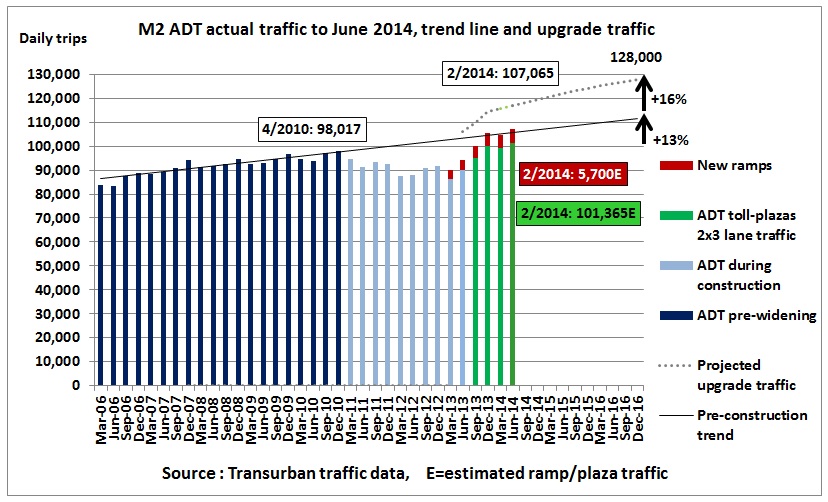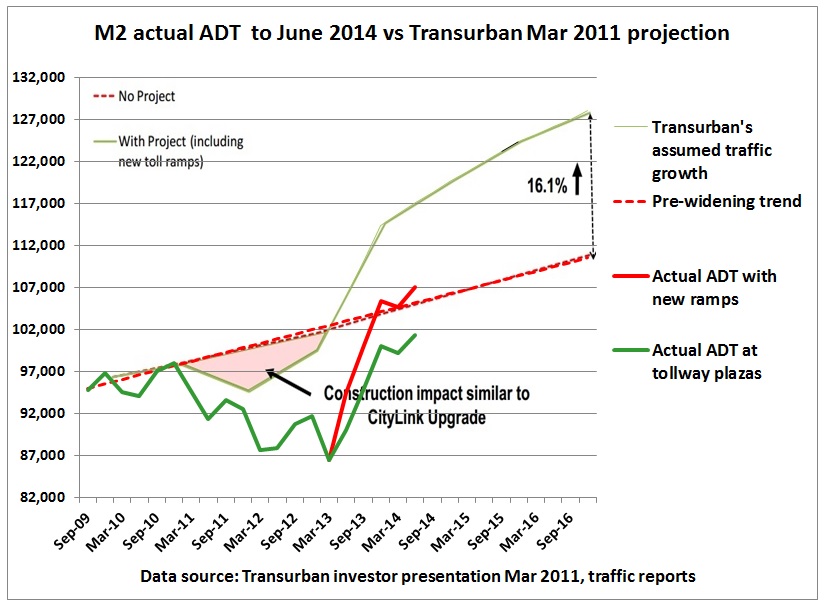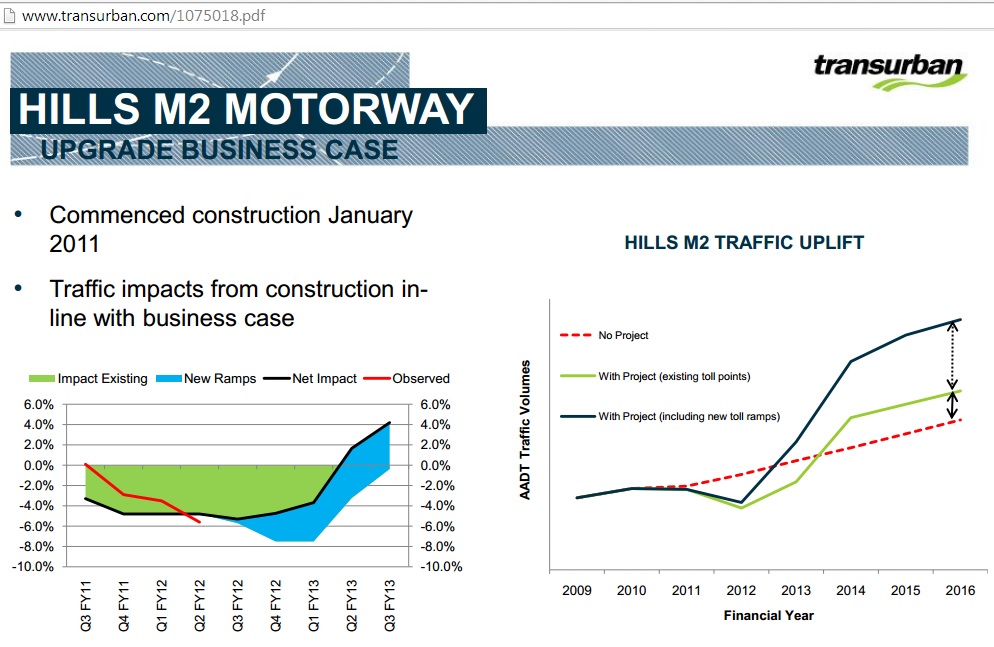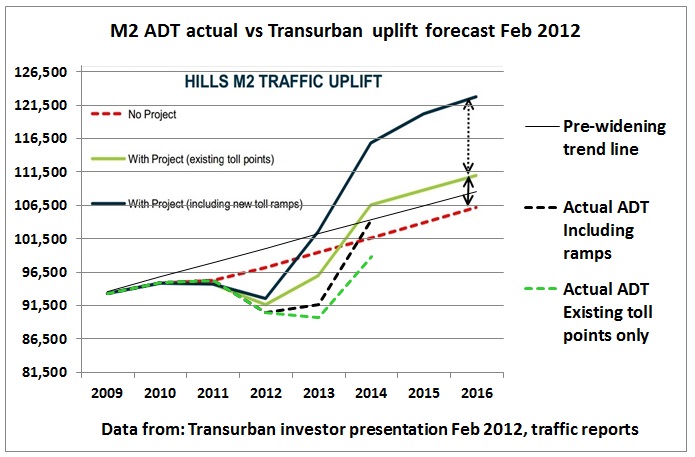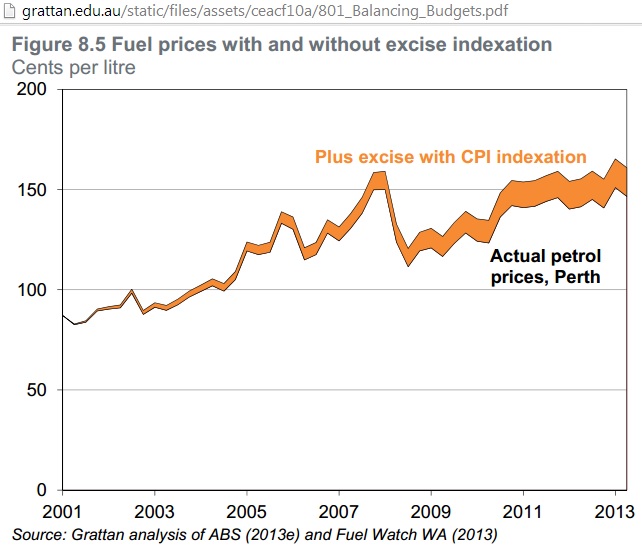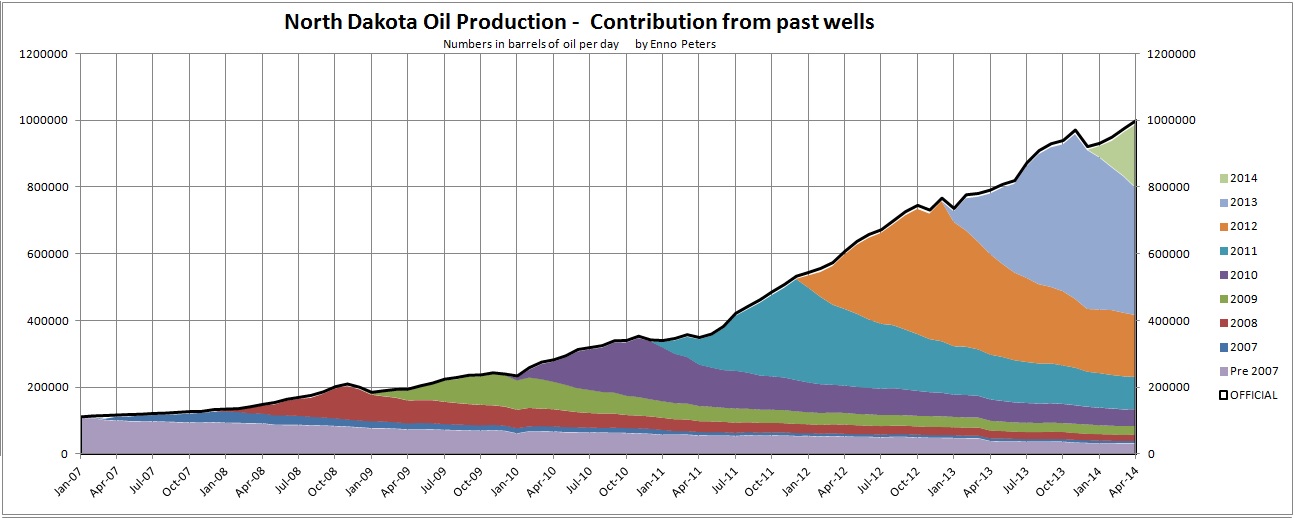Fig 1: M2 at Murray Farm Rd – summer evening 2013/14
The Sydney Morning Herald quotes from Transurban’s latest June 2014 ADT data that traffic on the M2 increased by 13.8% y-o-y.
The Sydney toll roads that are getting busier 10/7/2014 “There were an extra 12,629 average daily trips made on the M2, a 13.8 per cent increase, on the back of the completion of a major upgrade in August last year.”
Fig 1: Extract from table shown by SMH
http://www.smh.com.au/business/the-sydney-toll-roads-that-are-getting-busier-20140711-zt326.html However, that growth rate has come about on the basis of reduced traffic volumes in 2012/13 due to the construction work during widening the M2. So we need to look at the long term trends and Transurban’s expected traffic growth which was used to lure investors to finance the M2 widening. That was the idea in March 2011:
Fig 2: Transurban’s forecast uplift traffic on top of previous growth trend
http://www.transurban.com/20110328_Investor_Presentation.pdf
Let’s have a look at actual ADT numbers:
Fig 3: Actual ADT versus upgrade traffic forecast by Transurban in March 2011(dotted line)
Before the widening, ADT grew annually by an average of around 2,100 per day or around 2.2% pa. Based on this growth June 2014 traffic was just 1.8% above that trend. But much of the traffic growth since upgrade work was opened to traffic in stages has come from new ramps, not the widening. June 2016 traffic without the new ramps (at the old toll-way plazas) was actually 3.6% down from pre-widening trends. Note that Transurban no longer reports ramp traffic separately, so this traffic was estimated at around 5,700 per day.
So this below-trend at old toll-way plazas suggests that the current toll of $6.23 (from Lane Cove Tunnel to the M7) may be too high. When looking at traffic through Epping – a favourite rat-race route to by-pass the M2, this becomes evident:
Prominent developer Bruce Lyon calls for tunnel to ease bottleneck 7/5/2014 “ONE of the key developers in the planned overhaul of the Epping Town Centre has called for the construction of a tunnel connecting Carlingford Rd with Beecroft Rd to alleviate traffic congestion.”
http://www.dailytelegraph.com.au/newslocal/news/prominent-developer-bruce-lyon-calls-for-tunnel-to-ease-bottleneck/story-fngr8gwi-1226907721994?nk=f928927bf9b4c59d91f03dd13d74908a
So where are we now?
Fig 4: Actual ADT superimposed on Fig 2
We are a long way off from what Transurban planned in Mar 2011. The original graph (Fig 2) says “indicative only” but the lines are spot on and can be easily recreated. But let’s double-check with another Transurban’s Investor presentation, from February 2012.
Fig 5: Transurban’s business case February 2012
http://www.transurban.com/1075018.pdf
Fig 6: Actual ADT superimposed on Fig 5
The graph shows that actual ADT (dark blue and green dashed lines) is far below the forecast.
Australian motorists in protected zone
The stubbornly high Australian dollar has reduced the impact of increasing global oil prices.
15/12/2013 Lucky country dodged $2 a litre bullet – for now
http://crudeoilpeak.info/lucky-country-dodged-2-a-litre-bullet-for-now
And Howard’s freeze of fuel excise indexation in 2000 when the GST was introduced (2001 election lolly) kept petrol prices lower than would otherwise be the case.
Fig 7: Impact of fuel indexation on petrol prices
http://grattan.edu.au/static/files/assets/e4d0d7ad/802_Balancing_Budgets_Supporting_Analysis.pdf
Toll Revenue
Fig 8: M2 toll revenue
During construction of the 3rd lanes tolls were kept at 2010 levels but increased by 22.2% when the new lanes were opened to traffic. As a result, revenue skyrocketed. Tolls will now increase at the rate of 1% per quarter, much higher than the CPI or even the RBA target of 2-3% pa.
Transurban’s destiny hangs on Iraqi and US shale oil
As highlighted in an earlier post, business as usual assumes i.a. that Iraq’s oil production will increase continuously in the next years until 2020 and beyond.
15/6/2014 World’s untested assumption on 6 mb/d of Iraqi oil by 2020
http://crudeoilpeak.info/worlds-untested-assumption-on-6-mbd-iraqi-oil-by-2020
In its latest Short Term Energy Outlook the EIA forecast that Iraq will not exceed its current production level of 3.3 mb/d through the end of 2015.
Fig 9: Iraq’s recent crude oil exports
http://www.eia.gov/oog/info/twip/twip.asp?src=Petroleum-b2
In fact, it is assumed that the whole Middle East will become the most peaceful place on earth.
On US shale oil, the more depleting oil wells are drilled, the steeper the decline after the inevitable peak, most likely before 2020.
Fig 10: Shale oil production in Bakken by year http://peakoilbarrel.com/
That peak will come as a surprise to many as the media is repeating the propaganda of the oil and gas industry that the US will become an energy exporter.
Back to the introductory SMH article:
“Director of the University of NSW’s Research Centre for Integrated Transport Innovation Travis Waller said the traffic growth is a positive because it demonstrates how public-private partnerships can successfully fund key infrastructure.
He said if traffic and revenue continue to increase on toll roads, more investors will be encouraged to back similar major projects.”
http://www.smh.com.au/business/the-sydney-toll-roads-that-are-getting-busier-20140711-zt326.html
The website of the UNSW innovation centre is here: http://www.rciti.unsw.edu.au/
But where is the innovation if traffic growth is based on oil which is the cause of so many deaths in the Middle East? Not to mention how to innovate PPPs, given past failures?
Clem 7 tunnel in Brisbane
http://crudeoilpeak.info/i-told-you-so/north-south-bypass-tunnel-clem7-brisbane
Airport Link in Brisbane http://crudeoilpeak.info/airportlink-brisbane
Cross City tunnel in Sydney http://crudeoilpeak.info/cross-city-tunnel
Lane Cove tunnel in Sydney http://crudeoilpeak.info/lane-cove-tunnel
Australia suffers toll concession failures
16/7/2013
“Lessons however appear not to have been learned, and a new generation of litigation-ready investors are now seeking redress for failed concessions. Currently at least three class action suits are progressing against companies that made ambitious traffic projections. Aecom has been hit by a $150 million suit over its Clem 7 tunnel projections in Brisbane; Parsons Brinckerhoff and Booz Allen Hamilton are fighting a lawsuit filed against them for their traffic projections for the Lane Cove tunnels in Sydney; and Arup became the latest target in May 2013 for its Brisbane Airport Link projections”
http://www.tunneltalk.com/Discussion-Forum-16Jul13-Australia-PPP-toll-tunnel-crisis.php
Yet, the Abbott government – together with State governments – wants to embark and yet another series of road tunnels, the so-called roads for the 21st century.
27/3/2014 Australian governments want to pay $810m subsidy for unviable road tunnel in Sydney as next oil price spike looms (part 1)
http://crudeoilpeak.info/australian-governments-want-to-pay-810m-subsidy-for-unviable-road-tunnel-in-sydney-as-next-oil-price-spike-looms-part-1
12/11/2013
Sydney’s Westconnex road tunnel proposal based on too many untested assumptions
http://crudeoilpeak.info/sydneys-westconnex-road-tunnel-proposal-based-on-too-many-untested-assumptions
5/9/2013
Melbourne’s East West Link tunnel proposal has low benefit cost ratio and high oil price risk
http://crudeoilpeak.info/melbournes-east-west-link-tunnel-proposal-has-low-benefit-cost-ratio-and-high-oil-price-risk
Conclusion:
The SMH article correctly quoted one annual growth figure for the M2 but failed to see this in the context of long-term growth trends which look average. These trends were supported by low Australian petrol prices, sheer luck given that planning documents for the M2 widening did not include any oil or energy calculations. To conclude that traffic growth trends will continue for the next 30 years, the lifespan of new toll-ways, would be very naïve.
Selected previous posts:
30/4/2014
M2 daily traffic growth below Transurban’s expectations
http://crudeoilpeak.info/m2-daily-traffic-growth-below-transurbans-expectations
9/11/2010
M2 widening increases Sydney’s oil vulnerability
http://crudeoilpeak.info/m2-widening-increases-sydney%E2%80%99s-oil-vulnerability
28/10/2010
Quick risk analysis for M2 widening (Part2)
http://crudeoilpeak.info/quick-risk-analysis-for-m2-widening-part-2
21/9/2010
RTA fails to present business case for M2 widening (part 1)
http://crudeoilpeak.info/rta-fails-to-present-business-case-for-m2-widening-part-1
19/6/2010
M2 widening: Primary Energy Dilemma for cars
http://crudeoilpeak.info/m2-widening-primary-energy-dilemma-for-cars



